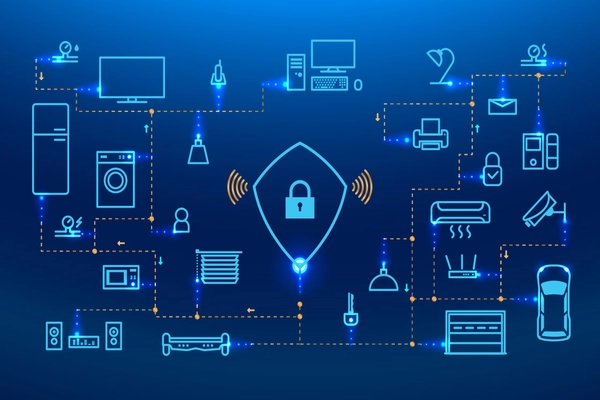The rapid growth of the Internet of Things (IoT) has enabled extensive connectivity between devices, people, and data systems. However, this open environment also introduces significant security risks. IoT security has therefore become a critical factor for all businesses, especially those operating on a large scale or relying heavily on smart devices. This article provides a comprehensive overview of IoT security, including its operation, associated risks, solutions, and the most advanced technologies currently in use.
What is IoT Security?
As the number of IoT devices rapidly increases across various sectors—from smart homes and manufacturing to logistics, energy, and healthcare—the need to protect data and prevent cyberattacks has become urgent. IoT security encompasses the methods, technologies, and processes designed to safeguard IoT devices, networks, and the data they transmit against unauthorized access, tampering, attacks, and sabotage.

IoT devices often have limited computing power, many lack advanced security features, and are vulnerable to exploitation. Therefore, IoT security is not just about setting up a firewall or using strong passwords. It is a comprehensive strategy that includes:
- Controlling access to devices
- Encrypting data during transmission
- Detecting and preventing abnormal behavior
- Updating firmware to patch security vulnerabilities
- Managing the device lifecycle
An IoT system is only truly secure when all components—from hardware and software to the cloud—are properly protected.
Types of IoT Security Today
IoT security is not a single solution but a combination of multiple layers of protection, covering hardware, software, connectivity, and data. Each type of security plays a distinct role in preventing attacks and safeguarding the entire IoT ecosystem. Before exploring how a system operates, it is important to understand the most common types of IoT security:
1. Hardware Security
Focuses on protecting chips, sensors, and controllers from physical tampering. Measures include:
- Secure Element (security chip)
- Secure Boot
- Firmware protection against unauthorized modification
2. Network Security
Prevents attacks on the data transmitted between devices and servers. Key measures include:
- TLS/SSL encryption
- VLAN segmentation
- Firewalls and VPNs for IoT networks
3. Data Security
Protects data throughout its journey from devices to analytics platforms. Mechanisms include:
- End-to-end encryption
- Digital signatures
- Data lifecycle management
4. Application Security
IoT applications that control devices must be secured to prevent hackers from taking over the system. Measures include:
- Role-Based Access Control (RBAC)
- Vulnerability scanning and penetration testing
- API protection
5. Cloud Security
Since most IoT data is processed in the cloud, cloud security is essential. Measures include:
- Multi-factor authentication
- Access rights management
- Cloud monitoring and anomaly alerts
How IoT Security Systems Work
To protect an entire IoT ecosystem, businesses need a security system that operates continuously, automatically, and across multiple layers. Each layer plays a specific role in keeping devices and data safe. A well-functioning IoT security system integrates hardware, software, network, data, application, and cloud protections, ensuring that all components are monitored and secured in real-time.

- Device and User Authentication: Every device must be authenticated before connecting to the system using digital keys, certificates, or identity management (IAM). This prevents unauthorized or counterfeit devices from accessing the network.
- Data Encryption During Transmission and Storage: Data from IoT devices is always encrypted using international standards, ensuring that even if packets are intercepted, hackers cannot read or alter the content.
- Continuous Monitoring and Anomaly Detection: The system leverages AI and machine learning to identify unusual behaviors, such as abnormal data transmission, sudden spikes in traffic, or unauthorized access attempts.
- Network Segmentation and Access Control: IoT networks are separated from the enterprise’s internal network, minimizing the potential impact of a security breach.
- Automated Incident Response: When a threat is detected, the system can automatically isolate devices, block connections, or require re-authentication to mitigate risks.
Popular IoT Security Solutions Today
Today, many innovative solutions have been developed to counter increasingly sophisticated attacks. These technologies not only enhance protection but also optimize operational costs for businesses. Below are three of the most notable solutions.

Applying SD-Branch Technology in IoT Security
SD-Branch (Software-Defined Branch) is a modern network management model that allows businesses to control their entire IoT connectivity system through a centralized platform.
Benefits of SD-Branch for IoT security include:
- Unified management of networks, security, and IoT devices within a single platform.
- Automated monitoring and classification of connected devices, helping detect unfamiliar devices or abnormal behaviors.
- Enhanced network segmentation, dividing the network into smaller zones to limit the spread of incidents.
- Integrated firewall to block unauthorized external access.
SD-Branch is particularly suitable for enterprises with multiple branches, a large number of IoT devices, and a need for centralized management to reduce risk.
Limiting Cloud Connectivity to Increase Security
Many IoT devices today continuously send data to the cloud. However, this can create multiple vulnerabilities if the provider does not ensure proper security.
The solution is to limit or optimize cloud connectivity, which means:
- Only sending necessary data instead of all raw data.
- Using Edge Computing to process data on the device or gateway before transmitting it.
- Applying strong encryption protocols such as TLS/SSL for all data streams.
- Enforcing strict access controls to prevent unauthorized users or devices from accessing the cloud.
This approach significantly reduces the risk of data leakage while improving processing speed.
Integrating Artificial Intelligence (AI) in IoT Security
AI and Machine Learning are becoming the “smart shield” for many modern IoT security systems due to their ability to detect anomalies in real time.
Applications of AI in IoT security include:
- Device behavior analysis: AI learns normal device operations and alerts when unusual activity is detected.
- DDoS attack detection: AI can immediately identify abnormal traffic patterns and automatically block access.
- Automated incident response: AI proposes or triggers defensive actions without waiting for human intervention.
- Security configuration optimization: AI adjusts security settings based on collected data.
AI is particularly useful for enterprises with a large and diverse fleet of IoT devices.
Other Solutions in IoT Security
To build a secure and stable IoT ecosystem, businesses need to implement a multi-layered security system rather than relying on a single solution. Key measures include:
- Regular firmware updates and prioritizing devices with Secure Element support to eliminate lingering vulnerabilities.
- Implementing a Zero Trust model—by default, no device or user is trusted unless authenticated.
- Identity and access management (IAM / RBAC) to control access rights for each device and user.
- Using IoT-specific firewalls combined with IDS/IPS to analyze behavior and detect unauthorized access.
- Establishing continuous monitoring and maintaining activity logs to trace incidents when they occur.
- Conducting regular security testing to identify potential vulnerabilities before they can be exploited.
- Training staff on IoT security to reduce risks from mistakes or lack of awareness.
Challenges in IoT Security
Despite the availability of advanced solutions, IoT security still faces numerous challenges due to the inherent nature of these systems. Businesses must understand these challenges clearly in order to develop appropriate and effective security strategies.

- Weakly Configured, Low-Cost Devices: Many IoT devices are not designed with security in mind from the start, making them highly vulnerable to hacking.
- Difficulty in Mass Firmware Updates: Managing firmware updates across thousands of devices is challenging, leaving many vulnerabilities unpatched.
- Data Distributed Across Multiple Locations: Data resides on devices, gateways, and the cloud, complicating overall data management and security.
- Increasing DDoS Attacks: Hackers can take control of IoT devices and turn them into botnets for large-scale DDoS attacks.
- Lack of Standardized Security Protocols: Different manufacturers use varying protocols and standards, making it difficult to implement uniform security measures.
Frequently Asked Questions About IoT Security
- Why are IoT devices often vulnerable to attacks?
Many devices have weak security settings, default passwords, lack encryption, or are not updated regularly.
- Is IoT security necessary for small businesses?
Yes. Even small-scale operations are at risk of data loss, operational disruptions, or having devices exploited to attack other systems.
- Can AI truly enhance IoT security?
Yes. AI can detect anomalies faster than humans and automatically respond to threats in real time.
- Is the cloud safe for IoT?
The cloud can be secure if proper encryption, access controls, and monitoring are in place. However, businesses should minimize sending unnecessary data to the cloud.
- Is SD-Branch suitable for all enterprises?
SD-Branch is most effective for businesses with multiple branches, a large number of IoT devices, and a need for centralized management.
IoT security is not only a technical requirement but also a critical strategy for protecting data, devices, and the entire connected ecosystem. By implementing effective IoT security solutions, organizations can prevent security risks, improve operational efficiency, build customer trust, and maintain a competitive advantage in the digital era.
